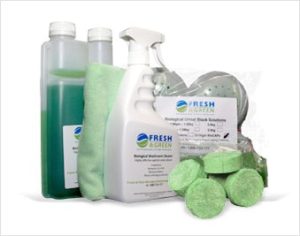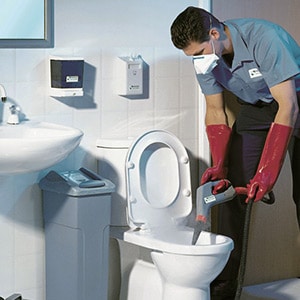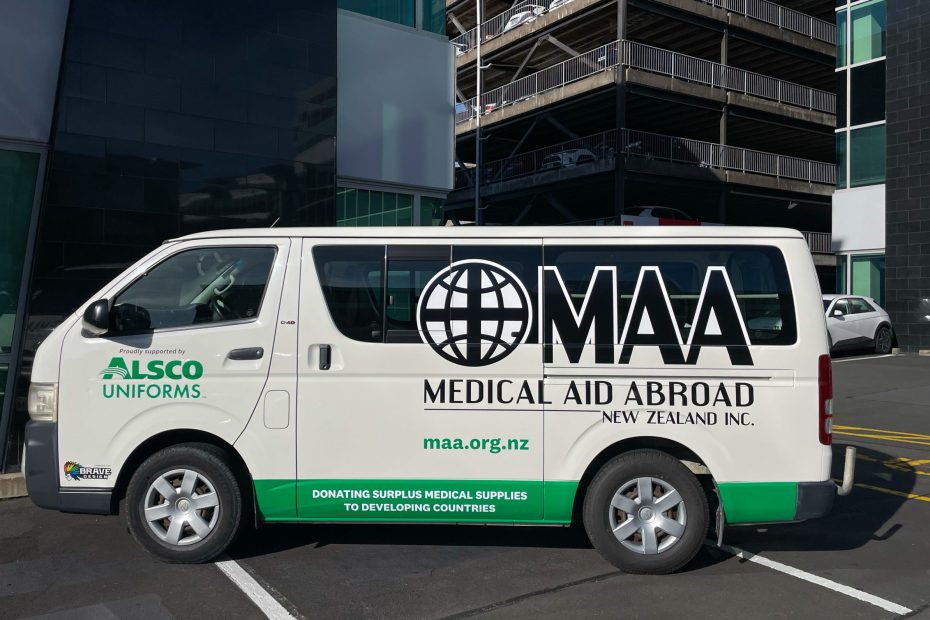1. How Do Waterless Urinals Work?
The science behind all waterless urinals is simple. The bowl of the urinal allows the urine to flow down to the strainer that catches debris.
Below the strainer is the sealing liquid where urine passes through and collects in the waste pipe below. The sealing liquid is simply vegetable oil or a specially formulated oil-based liquid.
Urine is able to sink through the sealing liquid due to the different densities of urine and oil. Urine tends to be denser than oil, so the oil will float and form a layer above the urine below.
This activity pushes the air bubbles out, and they rise to the top of the oil after escaping. The urine is therefore in a low-oxygen environment, which traps the odour. This is why waterless urinals are great in preventing washroom odour.
The urine is slowed down significantly before it meets the oil. This is to prevent oil from flowing into the waste pipe. When the urine is in the waste pipe, simple displacement sends it down the plumbing system. For context, the densities of the liquids involved are as follows:
- 823 kg/m3 – Ammonia
- 920 kg/m3 – Oil
- 1021 kg/m3 – Water
Waterless urinals exist in two varieties: cartridge-based and non-cartridge-based. Cartridge-based units are pre-filled with sealing liquid. The cartridges are replaced after a couple of months as the sealing liquid degrades or erodes. Non-cartridge units introduce sealing liquid into the drain hole to allow it to naturally settle into the correct position.
2. What Stops the Urine From Crystallising?
The liquid sealant filters and breaks down the uric sediment. Since urine is 97% water and 3% waste, by the time it runs down the waste pipe, most of the waste is already removed and any remaining sediments are filtered by the sealing liquid.
3. Are They Easy to Install?
One of the great things about waterless urinals is how easy they are to install. In no longer than one hour, you should be able to comfortably install each unit. If you’re doing it for a new building, you don’t need a water supply connected, and this significantly decreases the installation time.
4. How Much Do They Cost?
The cost per unit averages anywhere between $250 – $500 per unit. With just your water savings, you will get a full return on investment in less than two years. Furthermore, it serves as a great marketing tool for commercial properties, as they can help earn LEED (Leadership in Energy and Environmental Design) credits.
5. Do They Come in Different Colours?
Most waterless urinals come in the standard sanitary white colour. However, some manufacturers allow for custom colour orders based on availability. Check with your supplier to find out.
However, with their sleek design, white waterless urinals already look great. You don’t need flashy colours to spruce up your washroom.
6. Do They Need Cleaning?
A clear distinction between waterless urinals and flush urinals is the absence of mineral residue. Therefore, regular scrubbing is not required. You also don’t need conventional urinal cakes thanks to the liquid sealant. A simple daily spray and wipe are recommended to keep the urinals fresh and clean. In high usage areas, consider cleaning them more than once a day.
7. What Cleaning Products Will I Need?

Normal cleaning sprays can do the job, but for best results, use a biochemical cleaning solution. These solutions are made up of bacteria that kill 99.9% of germs and are so safe that you can drink them!
The biochemical solutions mimic nature. The best way to get rid of something is to find another that can eat it. Good quality solutions are packed with harmless ‘bugs’ that consume bacteria and germs without damaging anything else on the washroom surface.
Furthermore, these ‘hungry microbes’ provide a lasting solution to smelly buildups. With regular use, they form a protective layer that keeps the toilet germ and odour-free. The toxic chemicals are usually a one-time solution that also ruin the environment.
8. How Often Do They Need Cleaning?

Clean waterless urinals as often as you would flushing urinals. Since they are easier to clean, it should take you a shorter time to finish. Daily cleaning is optimal to keep the washrooms pristine.
Once in a while, it’s great to have deep cleaning that gives your washrooms a thorough washing to eliminate all bacteria.
You can do it yourself or call in experts who clean all corners of urinals, toilets, shower cubicles and other washroom elements.
Normal cleaning is often not enough to maintain presentable and safe washrooms. Schedule regular deep cleaning for your building or office.
9. Do I Have to Open the Trap to Clean It?
No, don’t open the trap. It only needs replacement 2-4 times per year depending on your urinal’s rate of usage. The cylinder also lasts a couple of months and needs changing 2-4 times per year. Different manufacturers have instructions for changing out the cartridges. Make sure you follow the instructions specific to your urinal to prevent damaging the system.
10. Must I Remove the Urinal for Waste Line Clean Out?
There’s no need for that. Simply use the provided key to remove the cartridge. Most plumbers love this feature, which allows easy access to pipes while saving time. It also saves you money in plumber fees.
11. Is the Liquid Biodegradable/Organic?
Yes, it is. Since it consists of mineral oils, alcohols and colour dye, it is fully biodegradable. It‘s the most effective sealing liquid on the market and most manufacturers use it in their units. Since it’s organic, it is also efficient and cost-effective.
12. How Do I Maintain the Waterless Urinal?
When it comes to maintenance, it’s important to regularly disinfect the units and replace the cartridge or any other relevant parts.
- Disinfecting
Although they are significantly more hygienic than flushing urinals, your cleaning staff needs to disinfect the units daily. If your urinals are in a high traffic area, clean them more than once a day to keep them fresh. - Cartridge Replacement
This is a crucial component to ensure your urinals work as they should. The frequency depends on how often they are used and the time elapsed. The recommended timeline is replacing them every three to six months.
Keep a maintenance log as a record of when they were last replaced and indicate the next time they should be replaced. Make sure your staff is aware of how to change the cartridge properly and are familiar with the manufacturer’s specifications.
13. What Is the Cost of Maintenance?
When you consider the cost of replacing cartridges, remember they need to be changed after about 7,000 uses and that the cost depends on your manufacturer.
For cleaning solutions and deep cleaning, consider hiring a vendor with monthly rental services. Only pay for what you need at an affordable monthly rate.
14. How Often Do I Need to Change the Sealant?
Usually, there’s no need to change the sealant. When you replace the cartridge, fill it with the new sealant provided. The sealant usually lasts as long as the cartridge.
However, as the urinal is in use, small amounts of the sealant are continuously drained into the waste line and need to be replenished. In high usage areas like a school, it could amount to two refills per month. The sealant needs to be replenished after 1,500 uses.
Accurately measure the three ounces needed to refill the sealant directly into the cylinder. Do this by using the ‘portion aid’ device provided by the manufacturer.
15. Do Many People Use Waterless Urinals?
Yes, they do. Their popularity increased with the need to conserve the environment and increase efficiency. Looking at only one manufacturer called Falcon, there are over 350,000 units in use all over the world! Even McDonald’s has a version of waterless urinals that won a toilet of the year award in 2009!
16. Can They Be Used in Schools?
In fact, they are perfect for high usage areas like schools. They are more hygienic, vandal-proof and they don’t block! Some even come with advertising space above the urinals that can be used to hang up hygiene messages like, “Wash your hands!”
17. Do They Smell?
Urine is typically odourless. An odour is present when it reacts with water and hydrolyses to create ammonia. With the absence of water in waterless urinals, this removes the reaction.
Furthermore, most units are non-porous and designed to channel every drop of urine through the sealant layer and down the drain. The sealant liquid creates an airtight seal that traps the urine and seals it from the restroom’s atmosphere. This means the sealant liquid prevents the back migration of sewer gases into the atmosphere.
With these mechanisms in place, waterless urinals are built for maximum odour resistance.
18. What Can I Do If They Smell?
When an odour is present, it is a sign that the urinals were not installed properly or are not well-maintained. For these reasons, prevention is better than a cure. During installation, ensure the urinals are plumbed with the proper pitch and placed downstream from a water source like the sinks. Some people include one flushing urinal to keep the sanitary line flushed to prevent urine buildup in the pipes.
Clean the urinals with waterless urinal cleaner to prevent emulsification of the sealant. The sealant should remain in tiptop shape in order to block out odour from the sewer lines or from trapped urine.
19. Why Choose Waterless Urinal Over Low-Flush Urinals?
Are waterless urinals better than reduced flush urinals? By a long shot! First, the cost of the low flush urinals is usually higher than that of waterless urinals. This is because you still factor in the cost of water per flush plus the cost of the unit.
Second, while the amount of flush water is reduced, the amount of urine usage remains the same. This creates limestone buildup in waste lines faster than regular high-volume flush toilets. Plumbers servicing high traffic areas can confirm this. It means that although water use is reduced, the maintenance costs go up since the waste pipe will need regular unclogging.
Waterless urinals have none of these problems.
Photo: Jetcarson





